What is the ChatGPT API?
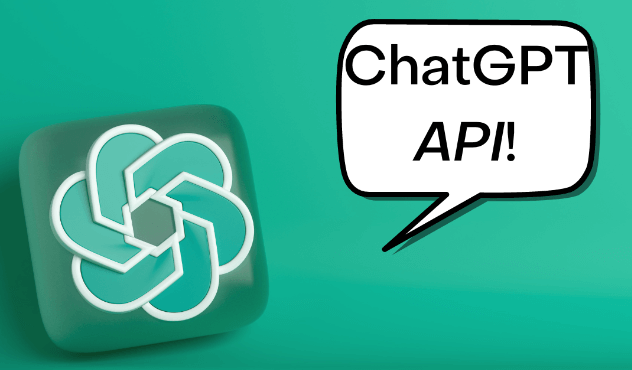
The ChatGPT API is a powerful tool allowing developers to incorporate ChatGPT's advanced language model's conversational capabilities into their apps, products, or services. It links developers' and ChatGPT's capabilities, allowing for smooth interactions with the model via a programmatic interface.
The ChatGPT API handles the underlying difficulties, such as language interpretation and generation, allowing developers to concentrate on developing entertaining and intelligent conversational apps. Developers may give consumers natural and context-aware interactions by harnessing the power of ChatGPT, increasing user experiences, and expanding the possibilities of their applications.
How ChatGPT API works?
The ChatGPT API works by giving developers a programmatic interface via which they may communicate with the ChatGPT model and integrate its conversational features into their apps or services.
- Authentication and Authorization: To use the ChatGPT API, developers must first log in and get API keys. These keys are used to identify and authorize the user performing the API requests.
- API Requests: Developers make API calls to the ChatGPT API server, indicating the desired action and offering input prompts or chat directions.
- Conversation Format: API requests are often formatted conversationally. Developers can initiate a discussion by sending a single message or a series of messages as input prompts. Each message has two properties: a 'role' (system, user, or assistance) and a 'content'. (The text of the message).
- Sending Messages: Developers may simulate a user's input or command by sending user messages to the API. These messages assist ChatGPT in comprehending the context and directing the conversation.
- Model Processing: On the server, the ChatGPT model analyses the API request and uses its language comprehension skills to evaluate the input messages, determine the context, and provide a response.
- Response Generation: The model provides a response based on the input messages and its knowledge of the conversation context. The response is included in the API response.
- API Response: The ChatGPT API server responds with the produced message from the helper role. This message can be extracted from the API response and used in apps or services by developers.
- Continuing the Conversation: Developers may continue the discussion by using past replies from the helper in subsequent API calls. This provides for context preservation and back-and-forth exchanges.
- Error Handling: Error messages or status codes may be included in the API response to indicate any problems discovered while processing. Developers must handle these faults in their apps correctly.
- Iterative Conversation: Developers can iterate the process by sending new API requests with updated prompts or instructions to have extended conversations or multiple turns.
By following this process, developers can leverage the ChatGPT API to create dynamic and interactive conversational experiences within their applications or services, enabling users to engage in natural, human-like interactions with the ChatGPT model.
Obtaining an API Key for ChatGPT
Developers need to receive an API key so as to use the ChatGPT API and its conversational capabilities. This key is used for authentication and provides access to the API server. Here is a step-by-step procedure to get a ChatGPT API key:
- Sign up for an OpenAI Account: Obtain an account by going to the OpenAI website and registering if necessary. Complete the registration procedure by entering the essential information.
- Navigate to the API Access Page (View API Keys): Navigate to the API access page after logging into your OpenAI account. This web page carries API information and permits you to control your API keys.
- Choose the ChatyGPT API: On the API Access page, select the option to "Create a new API (secret) key." This will take you to the API key creation interface.
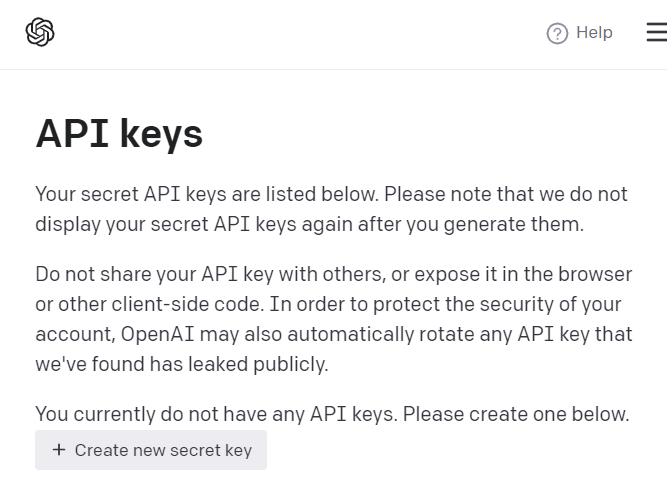
- Provide Necessary Details: In the API key creation interface, you may need to provide additional information, such as the API's purpose and intended application or service. Fill out the required fields accurately.
- Agree to Terms and Conditions: Review and agree to the terms and conditions for using the ChatGPT API. Ensure you understand and follow any usage limits or instructions presented. Keep the key secure since it serves as your authentication credential.
- Obtain the API Key: After completing the necessary steps and agreeing to the terms, the API key will be generated for you.
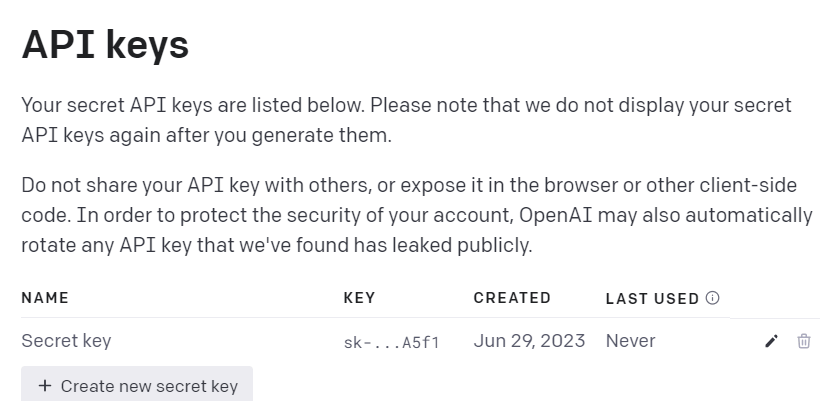
How can developers make use of OpenAI's ChatGPT API?
Developers can leverage OpenAI's ChatGPT API to enhance their applications with conversational AI capabilities. The API provides a straightforward way to integrate ChatGPT into software systems, allowing for interactive and dynamic interactions with users. Here's a step-by-step guide on how developers can utilize the ChatGPT API:
- Obtain an API Key: Developers need to acquire an API key from OpenAI to access the ChatGPT API. The key serves as an authentication mechanism and grants access to the API endpoints.
- Understand the Request-Response Mechanism: Developers interact with the ChatGPT model by sending a series of messages as input and receiving model-generated messages as output. Each message includes a role (system, user, or assistant) and the content of the message. Developers can create fluid and context-aware conversations by maintaining context across messages.
- Craft User Inputs: Developers should construct user messages that effectively convey the desired user input or query. Clear and specific user instructions help the model understand the desired task and generate accurate responses.
- Process Assistant Responses: Upon receiving the model-generated assistant responses, developers can process and present them in their applications. They can extract relevant information or modify the responses as needed to enhance the user experience.
- Handle Conversational Flow: Developers can design conversation flows by chaining user and assistant messages together to create a meaningful exchange. This allows for multi-turn conversations, enabling users to have extended interactions with the ChatGPT model.
- Iterate and Experiment: Developers are encouraged to iterate and experiment with different prompts, instructions, and message formats to optimize the model's performance and generate high-quality responses.
Advantages of ChatGPT API
The ChatGPT API offers several advantages that empower developers to create dynamic and interactive conversational experiences. Here are some key advantages of using the ChatGPT API:
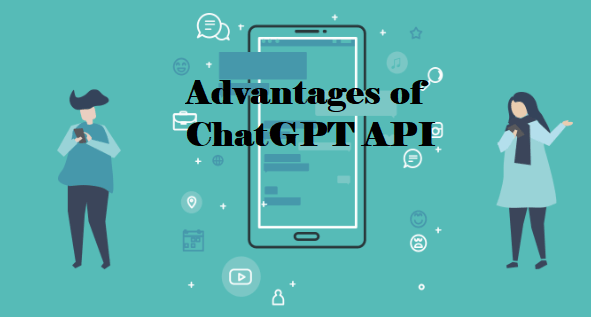
- Seamless Integration: The ChatGPT API offers a programmatic interface via which developers may easily incorporate the ChatGPT model into their own programs, businesses, or services. This seamless interface allows developers to harness the potential of conversational AI without requiring substantial knowledge of natural language processing.
- Natural Language Understanding: The ChatGPT model, underlying the API, has advanced language understanding capabilities. It can interpret and comprehend user messages, understanding context, nuances, and instructions, which enables it to generate relevant and accurate responses.
- Human-like Conversation: With the ChatGPT API, developers can create chatbots, virtual assistants, or conversational agents that engage in human-like conversation. The model's ability to generate context-aware responses helps create more natural and engaging interactions, enhancing user experiences.
- Customization and Fine-tuning: The ChatGPT API offers opportunities for customization and fine-tuning. Developers can adapt the model to specific domains, industries, or use cases by providing task-specific instructions and fine-tuning the model on relevant data. This customization enhances and tailors the model's performance to meet specific application requirements.
- Increased Efficiency: Developers may automate and simplify many activities that need human-like communication by utilizing the ChatGPT API. This boosts efficiency, eliminates manual labor, and frees human resources for more complicated or valuable activities.
- Real-time Interactions: The API enables real-time interactions with the ChatGPT model. Developers can send messages and receive responses in near real-time, allowing for interactive conversations that feel responsive and dynamic.
- Versatile Use Cases: The ChatGPT API has several uses in various sectors. It may be used to create customer service chatbots, virtual assistants, content production, language translation, and other applications. Because of the API's adaptability, developers may use it in a variety of fields.
- Ongoing Updates and Improvements: As OpenAI continues to refine and enhance the ChatGPT model, developers using the API can benefit from these updates without having to make significant changes to their integration. This ensures that applications leveraging the ChatGPT API stay up-to-date with the latest advancements in conversational AI.
Limitations of ChatGPT API's
- Response Coherence: The ChatGPT model may occasionally generate responses that need more overall coherence or consistency, resulting in nonsensical or irrelevant answers. Developers need to handle and filter such responses to ensure high-quality output carefully.
- Sensitivity to Input: The model is highly sensitive to the input phrasing and can yield different responses based on slight modifications. This means that the same question rephrased may result in different answers, which can be challenging when seeking consistent behavior.
- Bias and Inaccurate Information: ChatGPT may inadvertently generate biased or inaccurate information like any language model. Developers should be cautious and implement measures to mitigate bias and fact-check information before presenting it to users.
Future Developments in ChatGPT API's
- Model Enhancements: OpenAI continues to work on improving the ChatGPT model by addressing its limitations and enhancing its capabilities. Future iterations include response coherence advancements, reduced biases, and better context understanding.
- Increased Customization: OpenAI aims to expand the customization options for the model, allowing developers to fine-tune it for specific domains or use cases. This would enable more tailored and accurate responses within specialized contexts.
- Multi-Modal Capabilities: OpenAI may explore integrating ChatGPT with other modalities such as images, audio, or video, enabling more interactive and immersive conversational experiences.
- Ethical Considerations: OpenAI recognizes the importance of addressing ethical concerns related to AI systems. Future developments may focus on promoting responsible AI usage, transparency, and fairness in the output of the model.
- User Feedback and Iterative Improvements: OpenAI values user feedback and iteratively improves its models based on real-world usage. This feedback loop helps refine the model and address user concerns, leading to future developments that align with user needs.
Real-world applications of the ChatGPT API
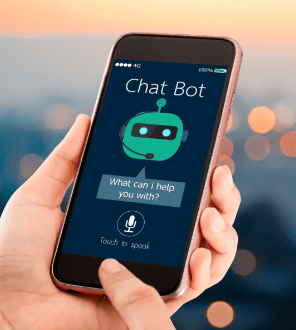
The ChatGPT API enables a wide range of real-world applications to exploit ChatGPT's conversational capabilities. Here are a few examples:
- Customer Support Chatbots: The ChatGPT API can power intelligent chatbots that handle customer queries, provide information, and assist with common support issues. It helps firms to provide 24-hour assistance and handle a large volume of consumer contacts.
- Virtual Assistants: Using the ChatGPT API, developers may construct virtual assistants who can arrange appointments, answer inquiries, provide recommendations, and assist with different chores. ChatGPT-powered virtual assistants may provide personalized and natural language-based interactions.
- Content Generation: Use the API to create material for blogs, articles, or social media postings. Developers may use ChatGPT to help them brainstorm ideas or even whole pieces of text.
- Language Translation: The ChatGPT API can assist in language translation by providing real-time translations between different languages. It can enable applications to act as virtual interpreters or aid users in understanding content in their preferred language.
- Conversational Games and Entertainment: Game developers can integrate the ChatGPT API to create interactive and engaging conversational game characters. These characters can respond intelligently to player inputs, enhancing the gaming experience.
- Language Learning: The ChatGPT API can be utilized in language learning applications to provide conversational practice and assistance. Learners can engage in conversations with the model, receive feedback, and improve their language skills.
- Interactive Storytelling: Developers can leverage the ChatGPT API to build interactive storytelling applications. Users can engage in conversational storytelling experiences, where the model response dynamically based on user inputs, leading to branching narratives.
Frequently asked questions
Can the ChatGPT API understand and respond to complex queries?
Yes, the ChatGPT API is intended to comprehend and reply to a wide range of requests. However, precise and detailed instructions are required to guarantee correct and meaningful replies.
How can I ensure that the ChatGPT API generates safe and ethical responses?
OpenAI provides guidelines and documentation to help developers ensure the responsible use of the ChatGPT API. In order to prevent the creation of harmful or inaccurate content, the output of the model must be carefully reviewed and moderated.
Are there any limitations on the number of API calls or the amount of data processed?
Yes, there are rate limits and pricing considerations associated with ChatGPT API usage. OpenAI provides details on the API pricing and usage policies, and developers can refer to the documentation for specific information.
Can I customize the behavior of the ChatGPT model through the API?
At present, fine-tuning the ChatGPT model is not available through the API. However, OpenAI provides guidelines on how to modify model behavior using system-level instructions within conversations. Experimenting with different prompts and instructions can help achieve desired outputs.
Is it possible to use the ChatGPT API in multiple languages?
Yes, the ChatGPT API supports multiple languages. You may communicate with the model by sending messages in several languages. However, it is crucial to remember that model performance may change among languages.
|



 For Videos Join Our Youtube Channel: Join Now
For Videos Join Our Youtube Channel: Join Now











